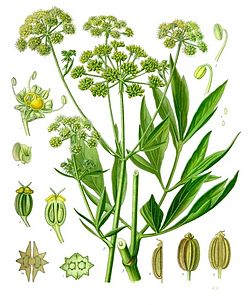
Lovage
Background to the schools Wikipedia
SOS Children, an education charity, organised this selection. To compare sponsorship charities this is the best sponsorship link.
| Lovage | |
|---|---|
 |
|
| Scientific classification | |
| Kingdom: | Plantae |
| Division: | Magnoliophyta |
| Class: | Magnoliopsida |
| Order: | Apiales |
| Family: | Apiaceae |
| Genus: | Levisticum |
| Species: | L. officinale |
| Binomial name | |
| Levisticum officinale L. Koch. |
|
Lovage (Levisticum officinale) is a plant, the leaves and seeds or fruit of which are used to flavor food, especially in South European cuisine. It is a tall (3 to 9 ft) perennial that vaguely resembles its cousin celery in appearance and in flavor. Lovage also sometimes gets referred to as smallage, but this is more properly used for celery.
The fruit of the lovage plant can be used as a spice, but what appears in the trade as lovage seed is usually ajwain, not lovage. On the other hand, what is sold as 'celery seed' is often partially or entirely ground lovage seed.
The root of lovage, which is a heavy, volatile oil, is used as a mild aquaretic. Lovage root contains furanocoumarins which can lead to photosensitivity.
Lovage is considered a "magic bullet" companion plant; much as borage helps protect almost all plants from pests, so lovage is thought to improve the health of almost all plants.
In Germany and Holland, one of the common names of Lovage is Maggikraut (German) or Maggiplant (Dutch) because the plant's taste is reminiscent of Maggi soup seasoning. In Romania the common name of Lovage is Leuştean.
Lovage tea can be applied to wounds as an antiseptic, or drunk to stimulate digestion. In the UK, Lovage cordial is traditionally mixed with brandy in the ratio of 2:1 as a winter drink. Lovage is second only to capers in its quercetin content .
See also: List of companion plants
|
||||||||||||||||||||||||||||||||||||||||||
